We follow TSA on Twitter. That’s a good thing since we have not seen this reported. Boy, we were very surprised to read that they had just reversed a ruling that we wrote about just two days ago.
Full-size Sunscreens are NOT OK per TSA revision.
New TSA guidelines went into effect last week when they announced that starting April 7, sunscreens became part of the TSA list of medically approved items. That meant that full-size containers were to have been permitted in your carry-on.
“TSA allows larger amounts of medically necessary liquids, gels, and aerosols in reasonable quantities for your trip, but you must declare them to security officers at the checkpoint for inspection.”
Yesterday TSA reversed their decision stating:
“Our website incorrectly reported that sunscreen containers larger than 3.4 oz were allowed in carry-on bags if medically necessary. That error has been corrected. Sunscreen in carry-on bags must be 3.4 oz or less. Larger quantities should be placed in checked bags.”
Fascinating comments about which sunscreens you pick and why.
Maria addressed physical sunblocks, saying: “I have been using mineral-based sunscreen for the past several years. If you’re confused about what to use, then look at the active ingredients. If the active ingredients are titanium dioxide and/or zinc oxide, then it’s OK. Some of the Banana Boat products are mineral-based, and that’s what we use. I’ve always worn a T-shirt when I snorkeled, and I started wearing swim leggings a couple of years ago, so now I need very little sunscreen.
Debbie addressed conflicting sunscreen ratings and SPF, adding, “You said these have a variety of spfs but I only found 30 and 50. I only wear 70 or above… I always wear a hat, sunglasses, and rash guard and use an umbrella but the reflection from the water still causes problems. Also Consumer Reports gives all the ones you mentioned average or bad ratings.This is very concerning.
Regular commenter Barbara concurred with many others about this one product, saying: “Two votes for Blue Lizard!!” Kaci concurred, “I am a pharmacist and I always recommend and use Blue Lizard. That’s one we have on hand ourselves.
Kathy added an interesting comment, “Avoid sunscreens with high content of Titanium Dioxide. This mineral does not biodegrade and is found to react in warm seawater to form hydrogen peroxide which is harmful to all sea life. Oxybenzone and octinoxate, the two chemicals recently banned in Hawaii and are believed to cause coral bleaching.”
Lastly Gene said, “I ran out of sunscreen on a trip to Oahu and I bought a bottle of Blue Lizard Australian Sunscreen, Sensitive, SPF 30+ at Longs after reading EWG reviews. It turned my skin white and I looked like a Kabuki actor until it was absorbed but it worked very well.”
From our last update:
Hawaii is still somewhat ahead of the curve and has banned sunscreens that can damage our marine environment and coral reefs. And of course our health. In the first such move of a U.S. state, Hawaii prevents the sale and distribution of sunscreens containing oxybenzone and octinoxate. These chemicals are found in literally thousands of sunscreens. The new law became effective on January 1, 2021.
“Our natural environment is fragile, and our own interaction with the earth can have lasting impacts…. This new law is just one step toward protecting the health and resiliency of Hawaii’s coral reefs.” — Governor David Ige.
World beaches enacting sunscreen bans
US Virgin Islands. A ban on chemical sunscreens and outlawing of imports and sales of products containing oxybenzone and octinoxate went into effect last year.
Bonaire. The island will ban the sale of chemical sunscreens in 2021.
Key West, Florida. Ban effective January 2021, stores cannot sell sunscreens containing reef-damaging chemicals. That was, however, struck down by a subsequent statewide law.
Palau. This was the first country to enact a sunscreen ban. It went into effect in 2020.
Aruba. Effective 2020, sunscreens containing oxybenzone have been prohibited.
Oxybenzone and coral reefs
In addition to health safety, one of the other huge issues is that a significant amount of sunscreen applied to your skin is released into the water. Over time, with Hawaii’s millions of visitors, voluminous amounts of sunscreen end up in our coral reefs. This causes coral damage, including bleaching, DNA injury, starvation, and reproductive and development issues. Reefs are an integral part of our marine ecosystem and are essential to the environment. According to NOAA, “coral reefs buffer adjacent shorelines from wave action and prevent erosion, property damage and loss of life.”
There are many other excellent choices for sunscreens that are safer both for you and for our precious environment. These are based on physical rather than chemical sun barriers.
How effective is your Hawaiian sunscreen?
We’ve been writing about staying safe under the Hawaii sun for more than 10 years. As always, your best protection is a shirt, hat, and proper sunglasses. But beyond that, here’s how to stay covered in the islands and elsewhere.
Safer and effective alternatives in Hawaiian sunscreen
Many new safer products are available compared with even a couple of years ago. Read on for some of the highest-rated sunscreen products that also feature low toxicity to you and the environment. These products still provide great sunburn (and questionable skin cancer) prevention caused by UVA and UVB exposure while not injuring Hawaii’s coral reefs.
The following families of products are among the safest and most effective (according to EWG) and the highest rated by consumers. They list 183 recreational sunscreens which meet EWG’s criteria. We’d love to hear your other suggestions and sources:
Thinksport Sunscreens (various SPF)
Kiss My Face Organics Sunscreens
Badger Sunscreens (various SPF) (Used by Beat of Hawaii editors)
JAMA study revealed new issues with chemical sunscreens.
Researchers have said that chemical sunscreens may be far more dangerous than previously revealed and that children maybe even more at risk from these chemicals than adults. A study in the medical journal JAMA revealed that common sunscreen products containing avobenzone, oxybenzone, ecamsule, and octocrylene need much more research. Blood concentration of these chemicals has for the first time been studied and found after just one day’s use. Serum levels rise with continued use and following application. It is questionable whether these products can be “generally regarded as safe and effective, ” which is FDA’s safety measure.
According to the study, “oxybenzone… has been found in human breast milk (and) in amniotic fluid, urine, and blood… Some studies… have raised questions about the potential for oxybenzone to affect endocrine activity.” Regarding Oxybenzone, the Environmental Working Group previously said CDC: “has detected oxybenzone in more than 96 percent of the American population… Participants who reported using sunscreen have higher oxybenzone exposures… Oxybenzone can cause allergic skin reactions and may disrupt hormones.”
What products have worked best for you?
Article updated 4/15/21.
Beat of Hawaii © photo on Oahu.
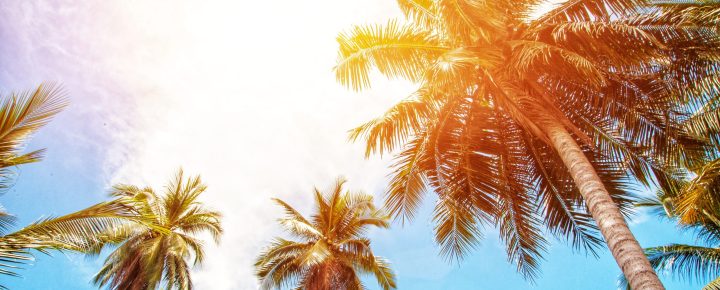

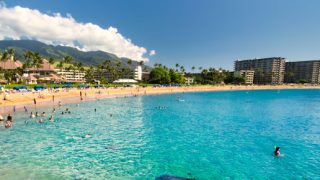
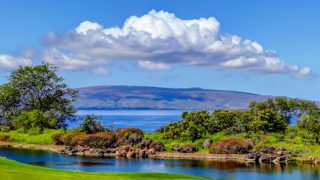
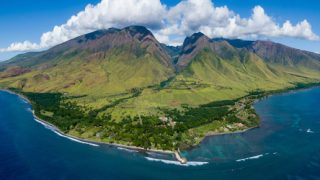
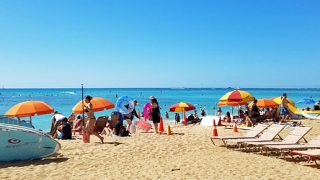
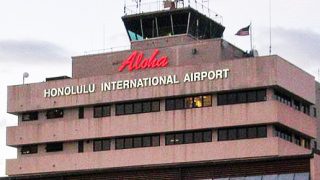
So we are going to Maui soon. We are staying at a place with a full kitchen. I have looked at delta and it states we can bring food in our checked bag. With the price of groceries we are considering bringing some items in our checked bags. Can we bring food into Hawaii in our checked bag if Delta allows it?
Yes, if you are arriving from the United States, you can bring food that’s cooked, canned, frozen, commercially processed and/or packaged. You cannot bring in citrus and pulpy fruits.
Hi, very glad to hear that Hawaii is leading the way to protect our marine lives. Thank you for writing this article to explain this issue in detail. We are in Hawaii visiting for the whole month of July 2021. We noticed one major chain store is carrying sunscreens with these chemicals, in fact, these bottles comprise the bulk of their sunscreen inventory. Is there a way to report this to the official? How are the retailers monitored?
Hi Ivy.
Good question. we aren’t aware of what monitoring the state is actually doing on prohibited sunscreens. If someone else does, maybe they can give us a hand.
Aloha.
SAFE TRAVEL HAWAII, Aloha folks. I have successfully landed on the Hawaiian Islands by following all the rules that each island stipulates. Since I am a guest, I would want to be welcomed warmly by the islanders, so why not agree to play by the rules? What is so hard to get tested within 72 hrs., practice filling out the SAFE TRAVELS, agree to any testing required upon landing? As a guest I am grateful that I am allowed to travel to these wonderful islands, and as part of the agreement, I will abide by their requests for safe travel. I didn’t find that any of the testing was invasive, I have my vaccination, and I want to travel safely and be welcomed wherever I visit. This seems to be the crux, we feel that our rights are being violated by testing, then wanting to get on a plane and land in paradise. It seems to be very simple, practice ALOHA, and ALOHA will happen.Thank you, Drew
DREW C… Congratulations on your long-awaited trip! I agree with everything you say. (I remember your posts about practicing filling out Safe Travels!) I will, however, strongly disagree with you about “What is so hard to get tested within 72 hrs.” As I’ve said before, for us to get tested with Rapid Results assurance, we have to drive 7 hours and stay an extra day in our departure city. That’s not a “not so hard” situation. Coincidentally, this morning on my dog walk, I encountered a “park friend” who told me that one of their family had to back out of their recent trip to Oahu because, although everyone in the family had gotten tested at CVS at the same time, that one person’s test results didn’t come back until 24 hours too late! I’m glad it went easily for you but not everyone is that lucky!
Hello Barbara,
I went to Oahu in June, when the Covid tests were still required. It was easy for me to get the Covid test done, but I live in a large city so I get this is more difficult if you have to drive 7 hours to your departure city.
What I did though was to schedule my test as close to the 72 hour max limit as possible – meaning if Monday at 9am was exactly 72 hours from my Thursday 9am departure, I scheduled my test for Monday at 10am. That way, if there was any sort of snafu on the lab’s part, there would still be enough time to allow for that to be rectified before my flight.
At the airport (LAX), I did see rapid testing labs set up outside the airport terminal area, but I would never want to cut it that close with a full Hawaii trip on the line.
As of July 8, visitors who are vaxxed on the mainland can now visit Hawaii without a Covid test or a quarantine. You do have to still register on the Hawaii State Travel website and have or create an account there in which you provide personal info like travel details, Covid tests results or vax information.
Regarding that family that had to back out of a Hawaii trip because one result came back 24 hours too late, do you know how far in advance of their flight did they get tested? If one party’s lab results came back 24hours after the flight, it sounds like perhaps they may have waited until 1 or 2 days prior to their flight to take their tests. If so, cutting it that close may have worked for most of the party but not for the one outlier. And even if all their lab results didn’t come back in time, were there any rapid results labs options (it literally takes 20 minutes or less to get the result) either in your town or at the airport that could have saved the day? Regardless, it’s all water under the bridge now and I am sad for them.
Thank you Gentlemen for your timely update. It’s very helpful in several ways.
Hi Roy.
Thank you too!
Aloha.
I would hope that airlines would have a handout for arriving passengers alerting them to this issue. Include it with the “invasive species” declaration that they handout before landing.